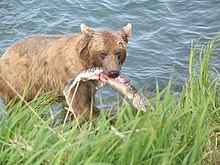
Back مجتمع (بيئة) Arabic Comunitat (ecologia) Catalan Βιοκοινότητα Greek Comunidad (ecología) Spanish Komunitate (ekologia) Basque جامعه (بومشناسی) Persian חברה (אקולוגיה) HE समुदाय (पारिस्थितिकी) Hindi Kominote (ekoloji) HT Komunitas (ekologi) ID

In ecology, a community is a group or association of populations of two or more different species occupying the same geographical area at the same time, also known as a biocoenosis, biotic community, biological community, ecological community, or life assemblage. The term community has a variety of uses. In its simplest form it refers to groups of organisms in a specific place or time, for example, "the fish community of Lake Ontario before industrialization".
Community ecology or synecology is the study of the interactions between species in communities on many spatial and temporal scales, including the distribution, structure, abundance, demography, and interactions between coexisting populations.[1] The primary focus of community ecology is on the interactions between populations as determined by specific genotypic and phenotypic characteristics. It is important to understand the origin, maintenance, and consequences of species diversity when evaluating community ecology.[2]
Community ecology also takes into account abiotic factors that influence species distributions or interactions (e.g. annual temperature or soil pH).[3] For example, the plant communities inhabiting deserts are very different from those found in tropical rainforests due to differences in annual precipitation. Humans can also affect community structure through habitat disturbance, such as the introduction of invasive species.
On a deeper level the meaning and value of the community concept in ecology is up for debate. Communities have traditionally been understood on a fine scale in terms of local processes constructing (or destructing) an assemblage of species, such as the way climate change is likely to affect the make-up of grass communities.[4] Recently this local community focus has been criticized. Robert Ricklefs, a professor of biology at the University of Missouri and author of Disintegration of the Ecological Community, has argued that it is more useful to think of communities on a regional scale, drawing on evolutionary taxonomy and biogeography,[1] where some species or clades evolve and others go extinct.[5] Today, community ecology focuses on experiments and mathematical models, however, it used to focus primarily on patterns of organisms. For example, taxonomic subdivisions of communities are called populations, while functional partitions are called guilds.
- ^ a b Sahney, S.; Benton, M. J. (2008). "Recovery from the most profound mass extinction of all time". Proceedings of the Royal Society B: Biological Sciences. 275 (1636): 759–65. doi:10.1098/rspb.2007.1370. PMC 2596898. PMID 18198148.
- ^ Morin, Peter J. (13 April 2009). Community Ecology. John Wiley & Sons. ISBN 978-1-4443-1231-7.
- ^ Dunson, William A.; Travis, Joseph (November 1991). "The Role of Abiotic Factors in Community Organization". The American Naturalist. 138 (5): 1067–1091. doi:10.1086/285270. S2CID 84867707.
- ^ Grime J. P.; et al. (2008). "Long-term resistance to simulated climate change in an infertile grassland". PNAS. 105 (29): 10028–10032. Bibcode:2008PNAS..10510028G. doi:10.1073/pnas.0711567105. PMC 2481365. PMID 18606995.
- ^ Ricklefs R.E. (2008). "Disintegration of the Ecological Community". American Naturalist. 172 (6): 741–750. doi:10.1086/593002. PMID 18954264. S2CID 17464820.
© MMXXIII Rich X Search. We shall prevail. All rights reserved. Rich X Search